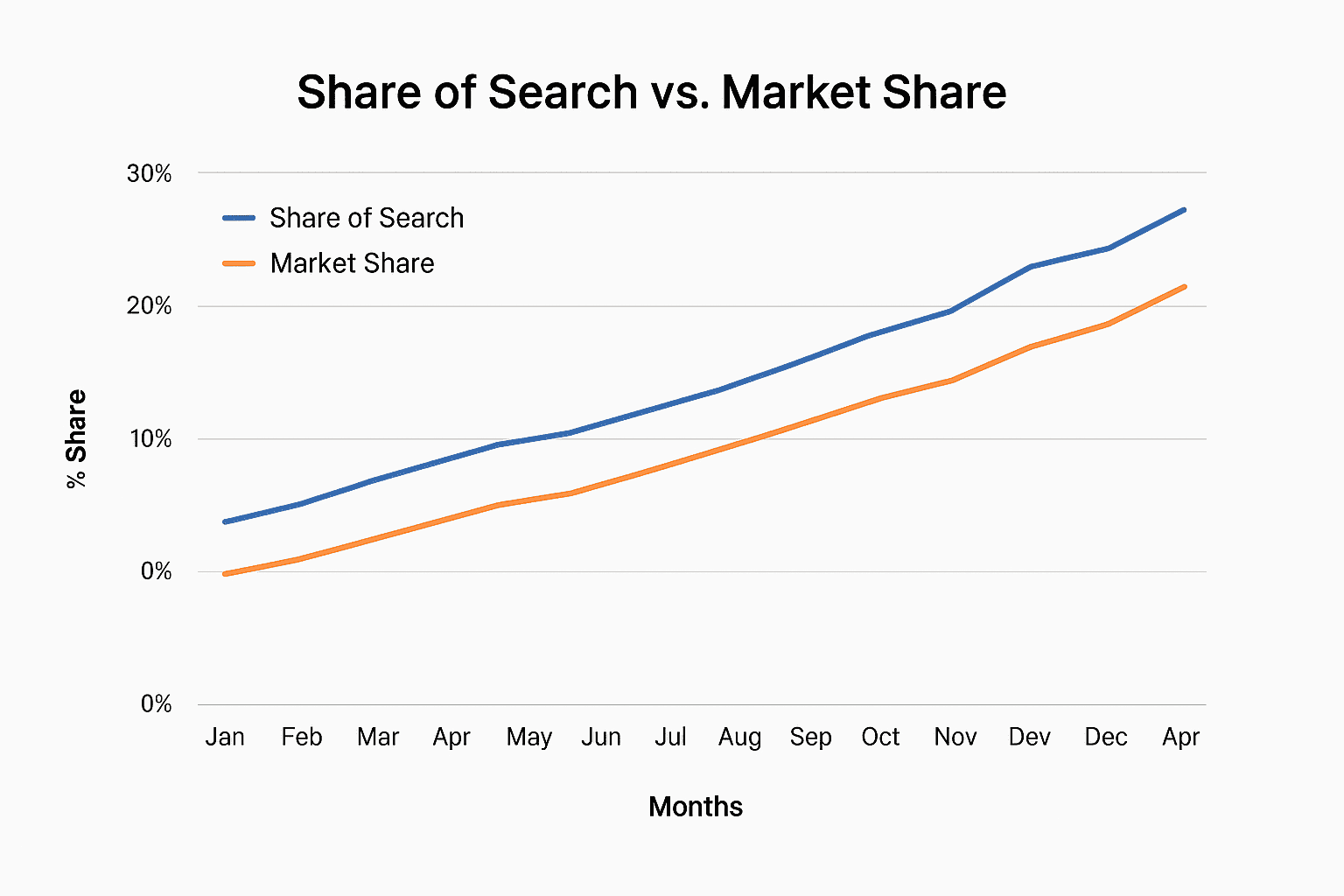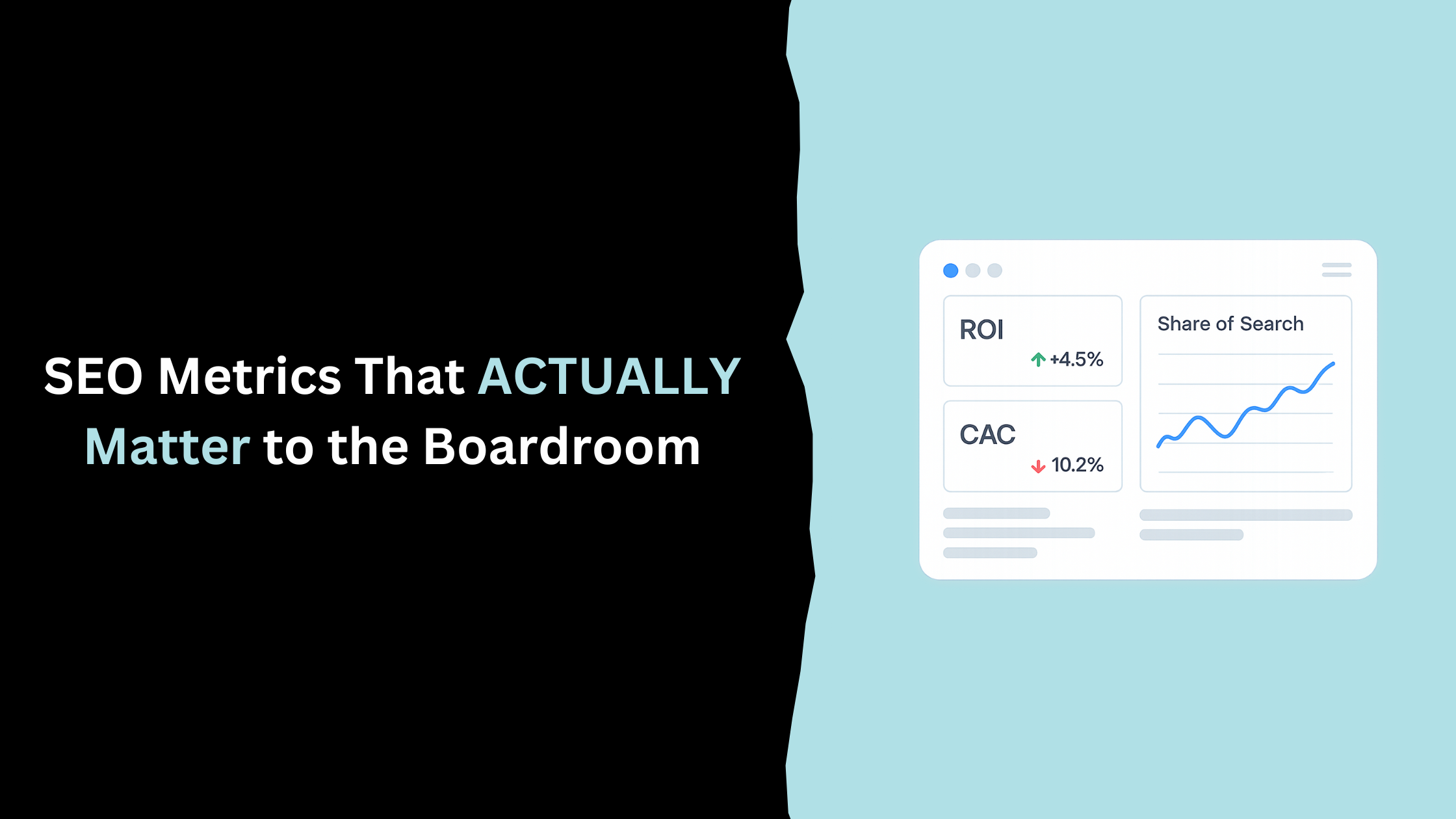Table of Contents
The Problem With Traditional SEO Reporting
Most SEO reports still look like they were written for other marketers - not executives. They’re packed with keyword charts, backlink counts, and traffic graphs that look impressive but fail to answer the only question that matters in the boardroom: “What did this do for the business?”
The issue isn’t that rankings or impressions are meaningless. They’re indicators of visibility. The problem is that they don’t show financial value. If organic sessions are up 30%, but revenue hasn’t shifted, the board won’t care.
Traditional SEO reporting also tends to measure inputs, not outputs. Teams spend time tracking keyword movements, crawl errors, and DA scores - all useful operationally - but none of these show whether SEO is helping the company grow faster or more efficiently.
To stay relevant in board-level discussions, SEO needs a translation layer - one that connects technical success to commercial outcomes.
What the Board Actually Cares About
Executives think in terms of business performance, not marketing metrics. They want to know how each activity contributes to growth, efficiency, or market position.
Here’s what they focus on:
- Revenue growth: Is organic search driving measurable sales or leads that turn into customers?
- Customer acquisition cost (CAC): Are we acquiring customers more efficiently compared to paid channels?
- Return on marketing investment: What’s the ROI from SEO compared to paid media, PR, or offline channels?
- Market share: Are we winning more of the market’s attention and demand compared to competitors?
- Brand strength: Is organic visibility helping the brand become the default choice in the category?
- Predictability and scalability: Can SEO performance be forecasted and scaled without equivalent cost growth?
When SEO aligns with these areas, it becomes more than a marketing tactic - it becomes a growth engine the board understands.
Reframing SEO Metrics Around Business KPIs
The easiest way to make SEO relevant is to map it directly to the board’s scorecard. Replace SEO metrics with their business equivalents.
This simple translation bridges the communication gap. When you show “SEO improved CAC efficiency by 25% compared to paid search,” you’re speaking in the board’s language.
Modern SEO Metrics That Matter
The SEO landscape has shifted. Generative AI, voice search, and local intent have redefined what visibility looks like. Measuring success now goes beyond blue links and traffic volumes. These are the metrics that genuinely matter to business performance today.

A. Share of Search
Share of Search measures the proportion of branded searches for your company versus competitors. It’s a direct indicator of brand demand.
When tracked over time, it often correlates with market share - making it a metric the board instantly understands. A rising share of search means your brand is being considered more often during the buying process.
To calculate it, use Google Trends or keyword data to compare branded search volume for your company and key competitors. Present it as a percentage trend over time.
B. Topical Authority
This measures how trusted your site is on specific subjects.
Google’s understanding of authority now extends to topic clusters, entity relationships, and content depth.
Use metrics like:
- Average rankings across content clusters
- Internal linking strength between related topics
- Backlink diversity within each theme
The stronger your topical authority, the higher your brand’s chance of dominating search results - including AI and voice responses.
C. Click Efficiency
Traditional CTR metrics don’t tell the whole story. Click efficiency looks at how well impressions convert into clicks that matter - clicks from commercial-intent keywords or branded terms.
It combines three metrics:
- CTR
- Branded vs. non-branded click mix
- Position stability over time
The result gives you a quality score for visibility - not just volume.
D. Content ROI
Every content piece should have a measurable financial outcome.
Map content to conversion paths using GA4 and CRM data, then attribute revenue back to the traffic source.
The formula is simple:
(Revenue from organic traffic ÷ SEO spend) = ROI
This turns your blog from a cost centre into a predictable revenue generator.
E. AI Visibility Metrics
With Google’s AI Overviews and Bing Copilot results, visibility is no longer limited to SERPs. AI Visibility measures how often your brand or content appears in AI-generated answers.
Track this using tools that scan SGE and generative responses. Pair it with engagement data from GA4 to see if impressions from AI results lead to branded searches or clicks.
If you’re consistently referenced in AI summaries, your brand is becoming part of the information landscape - and that’s long-term authority.
F. GEO SEO Metrics
For location-based businesses, map visibility and local pack share are vital. Track metrics like:
- Local pack impressions vs. total queries
- Clicks from Google Maps listings
- Review volume and sentiment trends
These directly influence revenue at the local level and help prove the ROI of local SEO investment.
How to Build a Board-Ready SEO Dashboard
A board-level SEO dashboard needs to speak in business outcomes, not keyword data. The goal is to connect search activity with money flow.
Step 1: Integrate multiple data sources
Pull data from GA4 (conversions and revenue), Search Console (visibility), CRM (pipeline and lead status), and your ad platform (benchmarking CAC). Use Looker Studio or Power BI to centralise this.
Step 2: Focus on financial metrics
Instead of sessions and rankings, highlight:
- Revenue per organic session
- Cost per organic lead
- Conversion rate by page type
- SEO-driven share of total sales
Step 3: Visualise SEO efficiency
Show comparisons like:
- Organic vs. paid CAC
- ROI over time
- SEO pipeline growth vs. total marketing pipeline
Step 4: Present trends, not snapshots
Boards care about progress, not one-off wins. Use quarterly trendlines for share of search, organic ROI, and traffic efficiency.
Step 5: Tie metrics to actions
For each metric, include one insight and one action - e.g., “Conversion rate improved 15% due to content restructuring - next quarter we’ll replicate the model for Product B pages.”
The outcome: a clear, commercial story about how SEO drives profitable growth.
Template: SEO Report Aligned to Business Goals
A board-ready SEO report should fit on two pages - or one clean dashboard - and follow a logical flow.
Executive Summary
- Organic growth vs. total marketing growth: Show whether SEO’s contribution is increasing relative to paid channels.
- SEO’s share of total new revenue: Highlight the percentage of new customer sales attributed to organic search.
Top takeaways: What’s driving growth? Where’s the next opportunity?
Key Metrics
Action Summary
- What worked: e.g., Product landing pages that improved conversion rate.
- What didn’t: Pages with high visibility but low engagement.
- Next steps: Strategic focus areas for the next quarter.
Optional Add-ons
If the board likes visuals, include:
- A simple “SEO ROI vs. Paid ROI” chart
- Share of Search vs. Revenue correlation graph
- Trend line for organic conversions over 12 months
This turns what used to be a technical report into a business growth summary.
Turning SEO Insights Into Board-Level Actions
The board doesn’t need to know about crawl budgets or H1 tags. They need to know how SEO decisions affect customers, revenue, and market dominance.
Here’s how to reframe SEO discussions:
- Keyword gaps → Market opportunities: “We found 20k monthly searches for competitor terms - capturing that traffic could represent £250k in annual revenue.”
- Technical fixes → Conversion improvements: “Site speed improvements reduced bounce rates by 12%, adding £40k in additional monthly sales.”
- Content creation → Brand trust and education: “Our new educational content drives 40% of assisted conversions - proving SEO helps nurture future buyers.”
This kind of reporting earns budget and trust. It shows SEO as a business investment, not a technical cost.
It also reframes SEO work as customer experience work. Fast-loading pages, rich content, and clear UX reduce acquisition friction - the exact kind of efficiency the CFO wants to see.
When you start presenting SEO outcomes in financial and behavioural terms, it becomes part of the commercial narrative - not a marketing afterthought.
Final Takeaway
SEO’s role these days is bigger than rankings. It shapes how people discover, evaluate, and trust your brand - both in search results and AI-generated answers.
But the conversation in the boardroom has to change. Instead of “traffic is up 20%,” the message should be “SEO drove £300k in pipeline growth while cutting acquisition costs by 30%.”
When you tie SEO metrics to revenue, CAC, and market share, you stop reporting on activity and start reporting on growth. That’s how you move SEO from a line item in the marketing budget to a measurable driver of business success.
Get in touch today
complete the form below for an informal chat about your business






.png)

